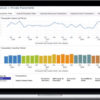Corporate Finance Institute – Cash Flow Cycles and Analysis
What keeps businesses going and owners up at night? Cash flow! Learn to talk and understand cash flow, and you’ll get your prospects’ and borrowers’ attention
Learn how businesses manage working capital and investment objectives
Determine the working capital funding gap, investment payback, and ROI metrics
Produce a cash flow statement to forecast, optimize, and outline strategies to support and enhance cash flow
In this Cash Flow Cycles and Analysis course, we look at how companies manage their cash flow. We will explore both the operating cash flow cycle and the investing cash flow cycle. We use real-world examples to calculate a company’s working capital funding gap. Then we will go over important strategies companies can use to optimize their working capital accounts.
From there we will look at the longer-term investments such as sustaining or expansionary capital expenditures. We will assess the payback time on a project and look at the return on investment. In the end, we’ll combine what we learned and produce a cash flow statement to compare key metrics such as net income, EBITDA, cash flow from operations, and free cash flow.
Throughout the course, we’ll be looking at things from both the lender’s perspective and the borrower’s perspective so you’ll have a full picture as a complete credit analyst of how to forecast and optimize cash flow for a business.
This Cash Flow Cycles and Analysis course is perfect for any aspiring credit analysts working in insurance, underwriting, rating agencies, commercial lending, corporate credit analysis, and other areas of credit evaluation.
What You’ll Learn In Cash Flow Cycles and Analysis?
Discuss the difference between a company’s short-term operating cash flow and long-term investing cash flow
Compare working capital objectives and capital investment objectives
Calculate working capital funding gap, investment payback and return on investment
Use a company’s financial statement to conduct a cash flow analysis and compare key metrics







